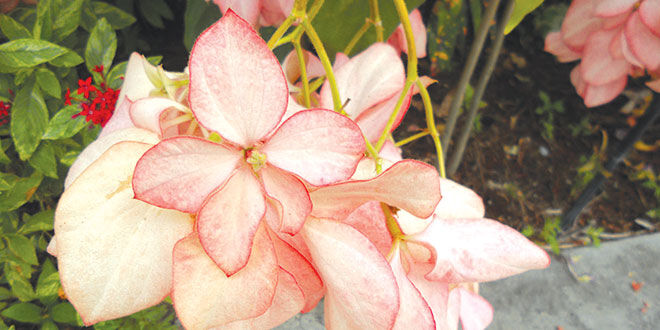PLANT TALK
Mike Malloy
mikemalloy@naplesbutterfly.comSightings of the Tropical Mussaendas are becoming more frequent in South Florida gardens. Making them colorful standouts amongst the mainly green Florida landscapes. There are over 150 varieties with only a handful seen here in South Florida landscapes. They are native Africa to Asia and are members of the coffee family (Rubiaceae). This plant also is commonly known as Tropical Dogwood. The names of the different Mussaendas were derived from the names of the First Ladies of Philippine Presidents.
Mussaendas are attractive shrubs that can reach the height of 12-15 feet, but can easily keep at a height of 5-6 feet and in a container even smaller, if so desired. They will stand a heavy pruning, but this should be done in the spring. They also may as they get older lack bottom branches. This is a perfect place to plant an understory plant to make the perfect landscape statement.
The flowers are small and tubular that both butterflies and hummingbirds love. The big
show is the colorful bracts which come in pink, red, white and yellow and various combinations, and all show up well against the sometimes light or dark green foliage.
Mussaendas can tolerate a lot of sun, but in Florida mid-day, full sun will not only cook an egg but will cook most plants. I have found that when labels on plants call for full sun it does not pertain to the state of Florida. It seems that whoever is in charge of information on plant labels has never spent a summer afternoon in Florida. I have found that most Mussaendas prefer some afternoon shade. Mussaendas can tolerate semi-shade, but when exposed to more light, it seems the shrubs will develop a stronger structure.
Mussaendas are not drought tolerant, so place them in your landscape with plants of equal water requirements. Do not overwater; like any plant, roots will be affected by over watering and may cause death. Use a slow release fertilizer as you do on
your other landscape plants every three to four months. It is also a good idea to do a couple of foliar applications of fertilizer a year. Using pine straw as mulch helps with the organic matter which helps the mussaendas with their nutritional needs.
Shrubs need a yearly pruning to reduce branches from becoming flower and leaf heavy and causing branches to break. If possible, plant them in a protected area to shield plants from heavy rains and strong wind damage.
Mussaendas have little problem with pests and are pretty disease resistant. Mealybugs and scale can infest a multitude of plants, including Mussaendas. Also be on the alert for spider mites and white fly. Remove clumps of old flowers to avoid any fungal problems.
I hope soon we get back to our normal winter temperatures so we don’t have to discuss this any longer, but if plants are damaged from cold temperatures it usually is limited to leaf drop. Plants will normally flush back out with the warmer weather.
KEEP BUTTERFLYING!!!!!!!!!
[email_link]




Post a comment as Guest
Report
Watch this discussion.
(0) comments
Welcome to the discussion.
Log In
Keep it Clean. Please avoid obscene, vulgar, lewd, racist or sexually-oriented language.
PLEASE TURN OFF YOUR CAPS LOCK.
Don't Threaten. Threats of harming another person will not be tolerated.
Be Truthful. Don't knowingly lie about anyone or anything.
Be Nice. No racism, sexism or any sort of -ism that is degrading to another person.
Be Proactive. Use the 'Report' link on each comment to let us know of abusive posts.
Share with Us. We'd love to hear eyewitness accounts, the history behind an article.